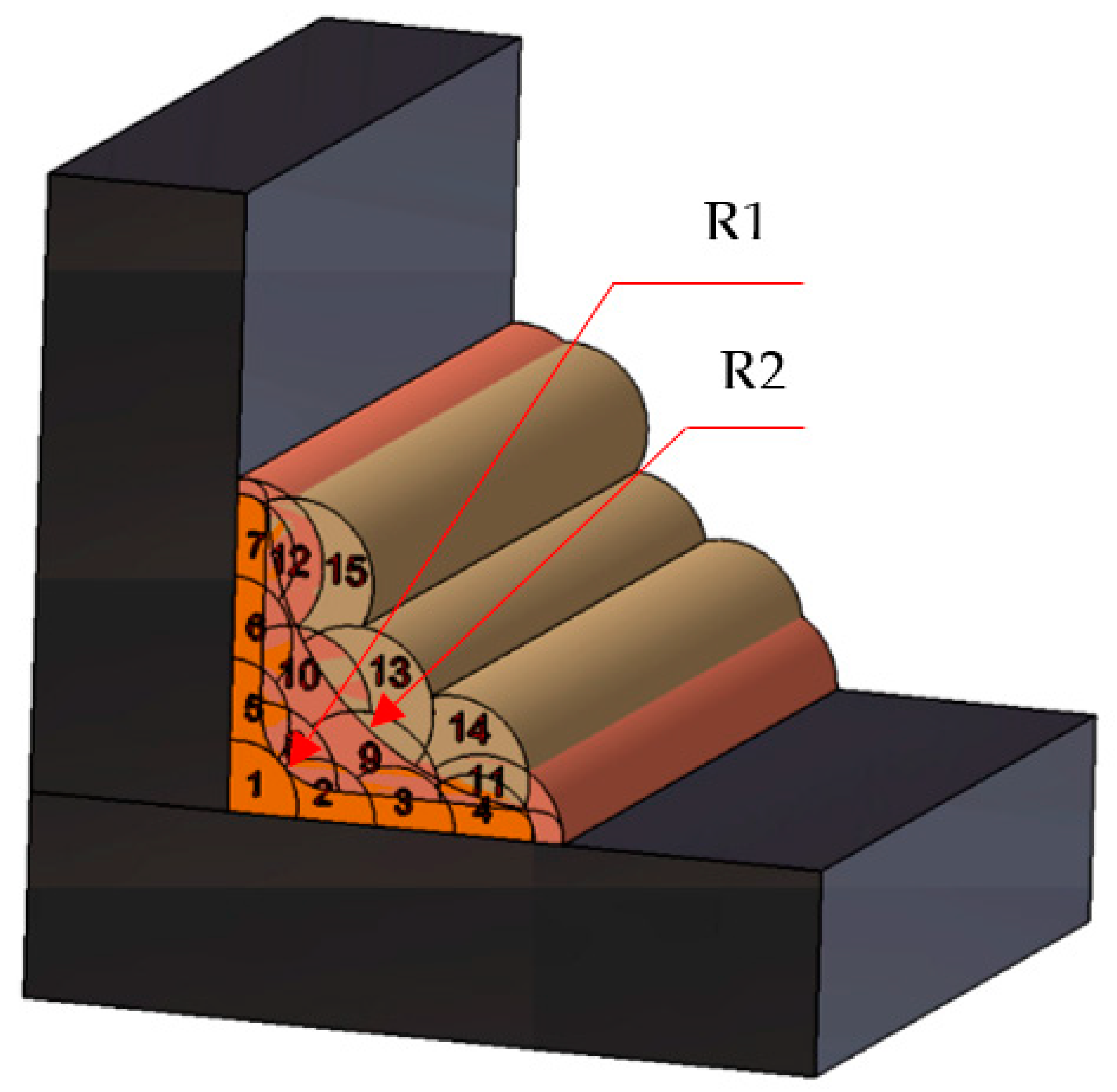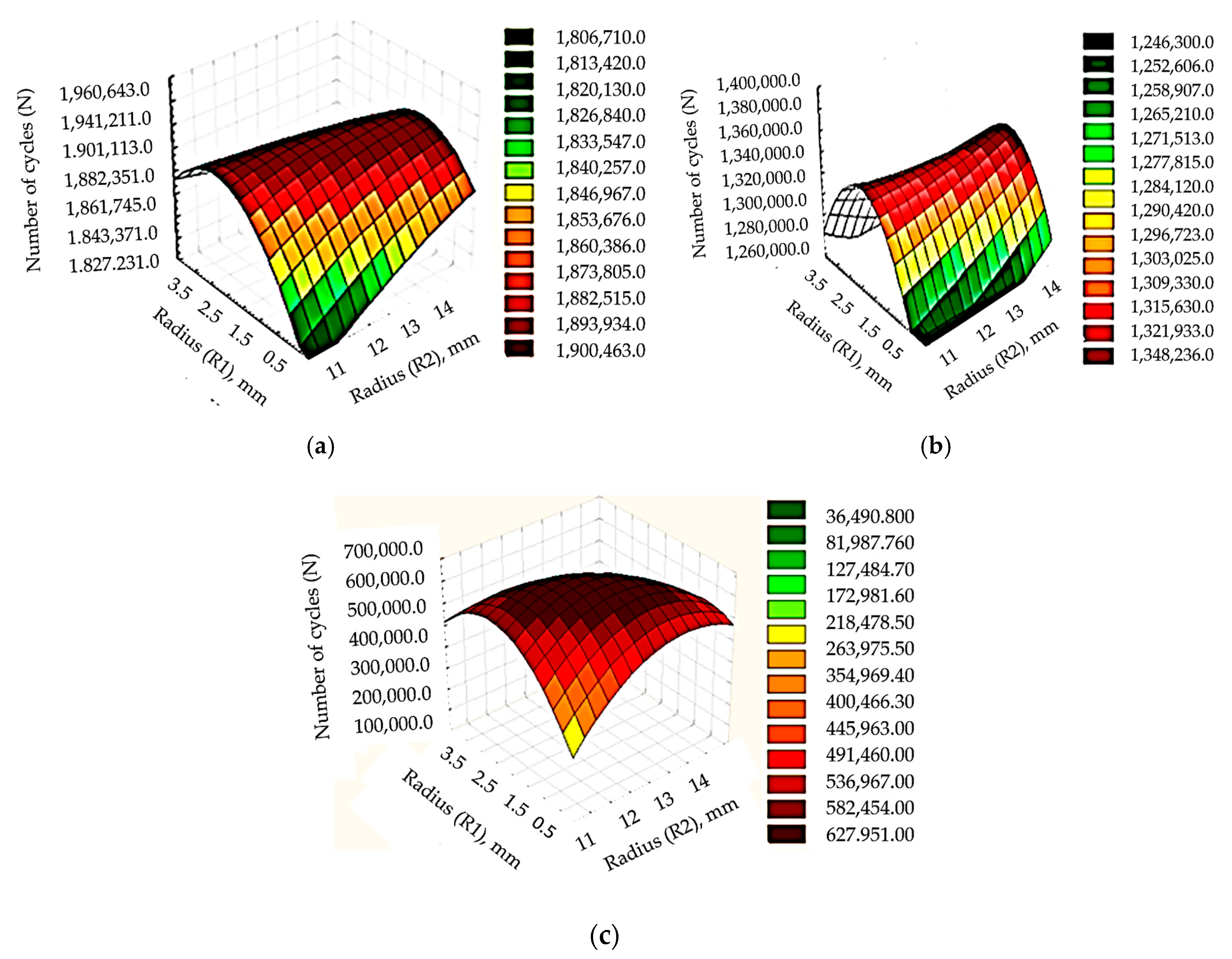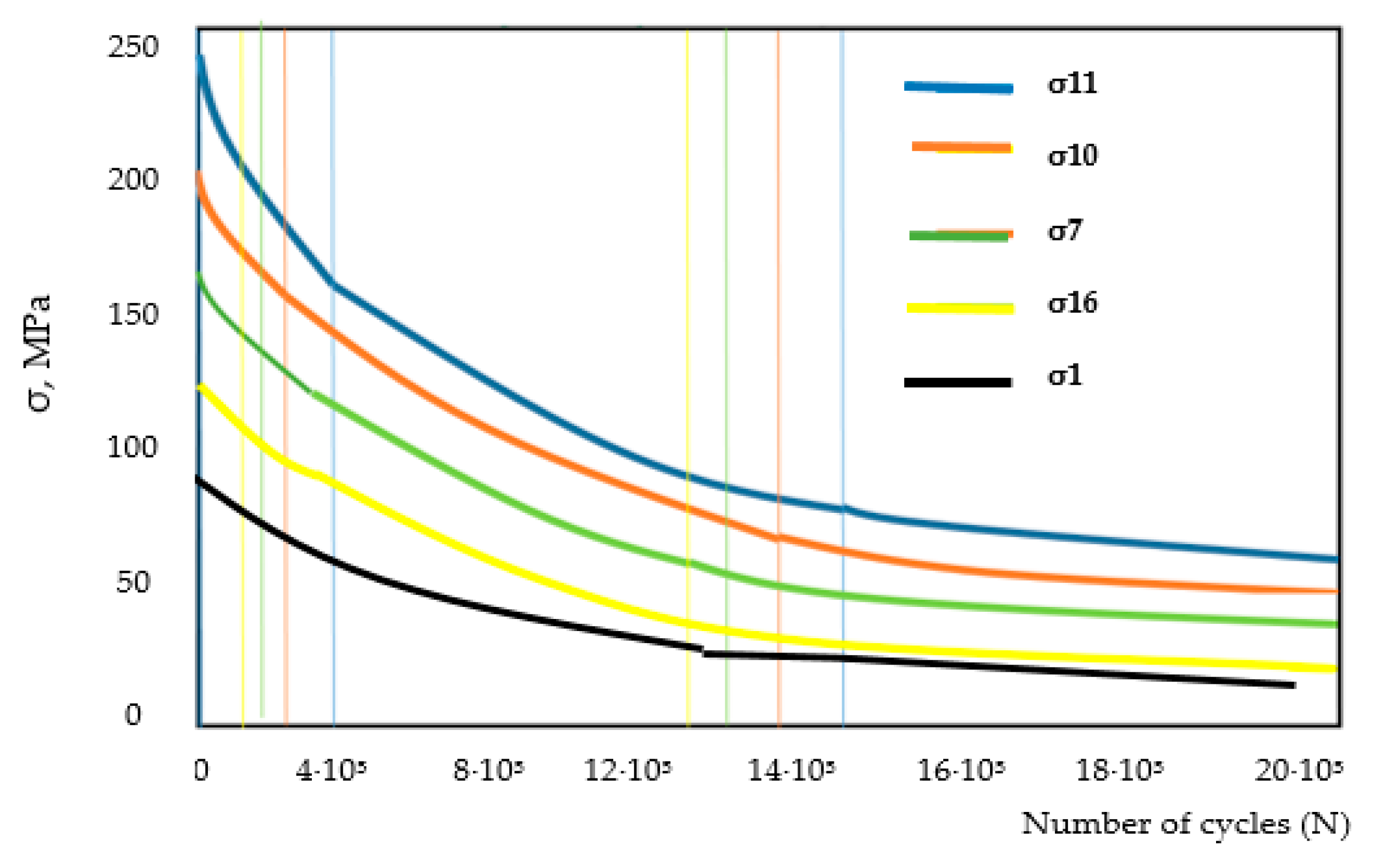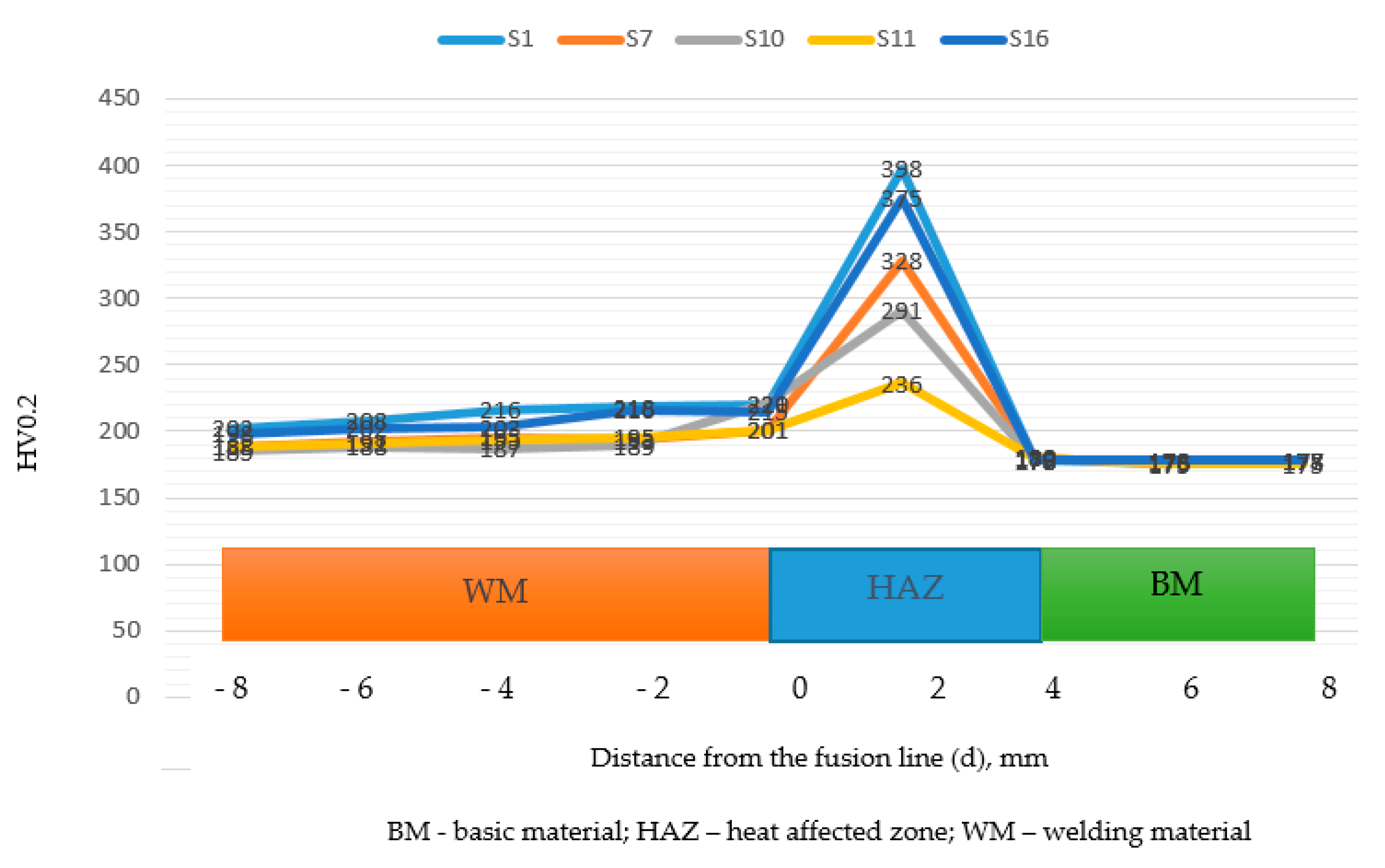Optimizing the Shape of Welded Constructions Made through the Technique “Temper Bead Welding”
Abstract
1. Introduction
2. Materials and Methods
2.1. Materials
2.2. The Method to Obtaining of Samples
2.3. Programming of Experiments
2.4. Testing the Fatigue Behavior
2.5. Determination of the Hardness of the Material from the Welded Joint
2.6. Analysis of the Metallographic Structure of the Material in the Welded Joint
3. Results and Discussion
3.1. The Results of the Analysis of the Fatigue Behavior
3.2. Results Obtained after Measuring the Hardness of the Material in the Samples
3.3. Residual Stresses Measurement
3.4. Analysis of the Microstructure of Materials from HAZ
4. Conclusions
- Fatigue resistance of the samples differed greatly depending on the values of the rays. Thus, the resistance to fatigue stress increased greatly from Nmin = 213,979 if R1 and R2 respectively do not have optimal values (R1 = 0.5 mm, R2 = 11 mm) at Nmax=582,454 if optimal values were used for R1 and R2 respectively (R1 = 2.5 mm, R2 = 13 mm ) for the situation in which the highest value of the load F3 = ±12 kN is applied;
- The highest value of material hardness in HAZ was 388HV0.2, approximately at the limit imposed by the AWS standard (AWS D3.6M: 2010), but the lowest value was 236HV0.2 obtained if R1 = 2.5 mm respectively R2 = 13 mm;
- Research has shown that choosing optimal values for R1, R2 causes reduced residual stresses in the welded joint;
- From the analysis of the microstructures in HAZ, it was observed that in the case of welding with TBW technique with values R1 = 2.5 mm respectively R2 = 13 mm, fine-grained perlite and ferrite microstructures appear, as a result of the heat treatment effect exerted by the additional welding seams on the previous ones, in the context of the overlapping of the welding seams. At the opposite pole, in the case of welding by TBW technique with the use, with the use of values of radii R1 = 0.5 mm, R2 = 11 mm, as a result of the introduction of a large amount of heat in the welded joint, hard microstructures appeared, with constituents of acicular martensite.
Author Contributions
Funding
Acknowledgments
Conflicts of Interest
References
- Tomków, J.; Fydrych, D.; Rogalski, G. Dissimilar underwater wet welding of HSLA steels. Int. J. Adv. Manuf. Technol. 2020, 109, 717–725. [Google Scholar] [CrossRef]
- Li, H.; Liu, D.; Ma, Q.; Guo, N.; Song, X.; Feng, J. Microstructure and mechanical properties of dissimilar welds between 16 Mn and 304 L in underwater wet welding. Sci. Technol. Weld. Join. 2018, 24, 1–7. [Google Scholar] [CrossRef]
- Rogalski, G.; Świerczyńska, A.; Landowski, M.; Fydrych, D. Mechanical and microstructural characterization of TIG welded dissimilar joints between 304L austenitic stainless steel and incoloy 800HT nickel alloy. Metals 2020, 10, 559. [Google Scholar] [CrossRef]
- Tomków, J.; Rogalski, G.; Fydrych, D.; Łabanowski, J. Advantages of the application of temper bead welding technique during wet welding. Materials 2018, 12, 915. [Google Scholar] [CrossRef]
- Benedetti, M.; Torresani, E.; Fontanari, V.; Lusuardi, D. Fatigue and fracture resistance of heavy-section ferritic ductile cast iron. Metals 2017, 7, 88. [Google Scholar] [CrossRef]
- Yuan, H.; Zhang, W.; Castelluccio, G.M.; Kim, J.; Liu, Y. Microstructure-sensitive estimation of small fatigue crack growth in bridge steel welds. Int. J. Fatigue 2018, 112, 183–197. [Google Scholar] [CrossRef]
- Dimitrescu, A.; Nitoi, D.F.; Dobrota, D.; Apostolescu, Z.; Apostolescu, Z. Researches and studies regarding brazed aluminium alloys microstructure used in aeronautic industry. Metalurgija 2015, 54, 583–586. [Google Scholar]
- Truong, T.-T.; Hsu, Q.-C.; Tong, V.-C. Effects of solid die types in complex and Large-scale aluminum profile extrusion. Appl. Sci. 2020, 10, 263. [Google Scholar] [CrossRef]
- Wang, F.; Yang, X.; Cui, L.; Yin, Y. Fabricating defect-free API X65 steel welds under underwater wet conditions using Friction Taper Plug welding. Mater. Manuf. Process. 2016, 31, 2123–2129. [Google Scholar] [CrossRef]
- Rogalski, G.; Łabanowski, J.; Fydrych, D.; Tomków, J. Bead-on-plate welding on S235JR steel by underwater local dry chamber process. Pol. Marit. Res. 2014, 21, 58–64. [Google Scholar] [CrossRef]
- Abe, F. Coarsening behavior of lath and its effect on creep rates in tempered martensitic 9Cr-W steels. Mater. Sci. Eng. A 2004, 387–389, 565–569. [Google Scholar] [CrossRef]
- Sun, Y.L.; Obasi, G.; Hamelin, C.J.; Vasileiou, A.N.; Flint, T.F.; Francis, J.A.; Smith, M.C. Characterisation and modelling of tempering during multi-pass welding. J. Mater. Process. Technol. 2019, 270, 118–131. [Google Scholar] [CrossRef]
- Ren, S.; Li, S.; Wang, Y.; Deng, D.; Ma, N. Predicting welding residual stress of a multi-pass P92 steel butt-welded joint with consideration of phase transformation and tempering effect. J. Mater. Eng. Perform. 2019, 28, 7452–7463. [Google Scholar] [CrossRef]
- Ghojel, J.I.; Ibrahim, R.N. Computer simulation of the thermal regime of double-loop channel induction furnaces. J. Mater. Process. Technol. 2004, 153–154, 386–391. [Google Scholar] [CrossRef]
- Yu, L.; SaSa, M.; Ohnishi, K.; Kameyama, M.; Hirano, S.; Chigusa, N.; Sera, T.; Saida, K.; Mochizuki, M.; Nishimoto, K. Neural network based toughness prediction in HAZ of low alloy steel produced by temper bead welding repair technology. Sci. Technol. Weld. Join. 2013, 18, 120–130. [Google Scholar] [CrossRef]
- Albuquerque, V.; Silva, C.; Moura, C.; Aguiar, M.; Farias, J. Effect of nonmetallic inclusion and banding on the success of the two-layer temper bead welding technique. Mater. Des. 2009, 30, 1068–1074. [Google Scholar] [CrossRef]
- Wang, Y.; Kannan, R.; Li, L. Identification and characterization of intercritical heat-affected zone in As-welded grade 91 weldment. Metall. Mater. Trans. A 2016, 47, 5680–5684. [Google Scholar] [CrossRef]
- Zondi, M.C. Factors that affect welding-induced residual stress and distortions in pressure vessel steels and their mitigation techniques: A review. J. Press. Vessel Technol. 2014, 136, 040801. [Google Scholar] [CrossRef]
- Ebrahimi, S.M.; Farahani, M.; Akbari, D. The influences of the cyclic force magnitude and frequency on the effectiveness of the vibratory stress relief process on a butt welded connection. Int. J. Adv. Manuf. Technol. 2019, 102, 2147–2158. [Google Scholar] [CrossRef]
- Hu, Y.; Shi, Y.; Sun, K.; Shen, X.; Wang, Z. Microstructure and mechanical properties of underwater hyperbaric FCA-welded du-plex stainless steel joints. J. Mater. Process. Technol. 2018, 261, 31–38. [Google Scholar] [CrossRef]
- Wei, P.; Li, H.; Liu, J.; Li, S.; Zhang, Y.; Zhu, Y.; Lei, Y. The effect of water environment on microstructural characteristics, composi-tional heterogeneity and microhardness distribution of 16Mn/304Ldissimilar welded joints. J. Manuf. Process. 2020, 56, 417–427. [Google Scholar] [CrossRef]
- den Besten, H. Fatigue criteria classification, modeling developments and trends for welded joints in marine structures. Ships Offshore Struct. 2018, 13, 787–808. [Google Scholar] [CrossRef]
- Dehghani, A.; Aslani, F. A review on defects in steel off shore structures and developed strengthening techniques. Structures 2019, 20, 635–657. [Google Scholar] [CrossRef]
- Tomków, J.; Janeczek, A. Underwater in situ local heat treatment by additional stitches for improving the weldability of steel. Appl. Sci. 2020, 10, 1823. [Google Scholar] [CrossRef]
- Tomków, J.; Fydrych, D.; Rogalski, G.; Łabanowski, J. Temper bead welding of S460N steel in wet welding conditions. Adv. Mater. Sci. 2018, 18, 5–14. [Google Scholar] [CrossRef]
- Wenbin, G.; Dongpo, W.; Fangjie, C.; Xinjie, D.; Caiyan, D.; Wei, X. Microstructural and mechanical performance of underwater wet welded S355 steel. J. Mater. Process. Technol. 2016, 238, 333–340. [Google Scholar]
- Lant, T.; Robinson, D.L.; Spafford, B.; Storesun, J. Review of weld repair procedures for low alloy steels designed to minimise the risk of future cracking. Int. J. Press. Vessels Pip. 2001, 78, 813–818. [Google Scholar] [CrossRef]
- Hanzaei, A.T.; Marashi, S.; Ranjabarnodeh, E. The effect of hydrogen content and welding conditions on the hydrogen induced cracking of the API X70 steel weld. Int. J. Hydrogen Energy 2018, 43, 9399–9407. [Google Scholar] [CrossRef]
- Tomków, J.; Łabanowski, J.; Fydrych, D.; Rogalski, G. Cold cracking of S460N steel in water environment. Pol. Marit. Res. 2018, 25, 131–136. [Google Scholar] [CrossRef]
- Chen, H.; Guo, N.; Zhang, X.; Cheng, Q.; Zhou, L.; Wang, G. Effect of water flow on the microstructure, mechanical performance, and cracking susceptibility of underwater Q235 and E40 steel. J. Mater. Process. Technol. 2020, 277, 116435. [Google Scholar] [CrossRef]
- Prajapati, P.J.; Badheka, V.J. Investigation on three different weldments on performance of SA516 Gr70 steel material. Alex. Eng. J. 2019, 58, 637–646. [Google Scholar] [CrossRef]
- da Cunha, T.V.; Bohórquez, C.E. Ultrasound in arc welding: A review. Ultrasonics 2015, 56, 201–209. [Google Scholar] [CrossRef]
- Amza, G.; Dobrotǎ, D. Ultrasound effect on the mechanical properties of parts loaded by welding. Metalurgija 2013, 53, 83–86. [Google Scholar]
- Sun, Q.J.; Cheng, W.O.; Liu, Y.B.; Wang, J.F.; Cai, C.W.; Feng, J.C. Microstructure and mechanical properties of ultrasonic assisted underwater wet welding joints. Mater. Des. 2016, 103, 63–70. [Google Scholar] [CrossRef]
- Aloraier, A.S.; Ibrahim, R.N.; Ghojel, J. Eliminating post-weld heat treatment in repair welding by temper bead technique: Role bead sequence in metallurgical changes. J. Mater. Process. Technol. 2004, 153, 392–400. [Google Scholar] [CrossRef]
- Shengf, D.; Yanfei, H.; Chuanbao, J.; Chuansong, W.; Maofu, Z.; Qingyuan, Y.; Jie, Y. Organic adhesive underwater submerged-arc weldin. J. Mater. Process. Technol. 2020, 284, 116739. [Google Scholar]
- Qazi, M.I.; Akhtar, R.; Abas, M.; Khalid, Q.S.; Babar, A.R.; Pruncu, C.I. An integrated approach of GRA coupled with principal component analysis for multi-optimization of Shielded Metal Arc Welding (SMAW) process. Materials 2020, 13, 3457. [Google Scholar] [CrossRef]







| C | Si | Mn | Al | Ni | Cr | Cu | Ti | O | Ce |
|---|---|---|---|---|---|---|---|---|---|
| 0.13 | 0.18 | 1.5 | 0.02 | 0.02 | 0.03 | 0.05 | – | – | 0.39 |
| Yield Strength Rp0.2 (MPa) | Tensile Strength Rm (MPa) | Elongation A5 (%) | Impact Toughness at −20 °C (J) |
|---|---|---|---|
| minimum | minimum | ||
| 392 | 520–550 | 29 | 275 |
| C | Mn | Si |
|---|---|---|
| 0.08 | 1.7 | 0.7 |
| Yield Strength Rp0.2 (MPa) | Tensile Strength Rm (MPa) | Elongation A5 (%) | Impact Values ISO-V KV (J) | |
|---|---|---|---|---|
| minimum | minimum | –40 °C | +20 °C | |
| 420 | 560–720 | 26 | 90 | 170 |
| Deposited Welding Layer | Number of the Welding Seam | Voltage U | Intensity A | Welding Speed Vs | Heat Input El |
|---|---|---|---|---|---|
| (V) | (A) | (mm/s) | (J/mm) | ||
| 1 | 21 | 100 | 3.05 | 688.52 | |
| 2 | 21 | 100 | 2.75 | 763.63 | |
| 3 | 21 | 100 | 2.72 | 772.05 | |
| I | 4 | 21 | 100 | 3.09 | 679.61 |
| 5 | 20 | 100 | 3.07 | 651.46 | |
| 6 | 20 | 100 | 3.17 | 630.91 | |
| 7 | 20 | 100 | 3.15 | 634.92 | |
| 8 | 21 | 140 | 1.82 | 1615.38 | |
| 9 | 21 | 140 | 1.91 | 1539.26 | |
| II | 10 | 21 | 140 | 1.79 | 1642.45 |
| 11 | 21 | 140 | 1.95 | 1507.69 | |
| 12 | 21 | 140 | 1.85 | 1589.18 | |
| 13 | 21 | 180 | 1.75 | 2160 | |
| III | 14 | 21 | 180 | 1.80 | 2100 |
| 15 | 21 | 180 | 1.75 | 2160 |
| Sample Number | Radius Values R1 [mm] | Radius Values R2 [mm] | ||||||
|---|---|---|---|---|---|---|---|---|
| 0.5 | 1.5 | 2.5 | 3.5 | 11 | 12 | 13 | 14 | |
| S1 | x | x | ||||||
| S2 | x | x | ||||||
| S3 | x | x | ||||||
| S4 | x | x | ||||||
| S5 | x | x | ||||||
| S6 | x | x | ||||||
| S7 | x | x | ||||||
| S8 | x | x | ||||||
| S9 | x | x | ||||||
| S10 | x | x | ||||||
| S11 | x | x | ||||||
| S12 | x | x | ||||||
| S13 | x | x | ||||||
| S14 | x | x | ||||||
| S15 | x | x | ||||||
| S16 | x | x | ||||||
| Samples | ±Force (kN) | Frequency (Hz) |
|---|---|---|
| 1÷16 | ±8 | 10 |
| ±10 | ||
| ±12 |
| F | The Mathematical Model | R-Squared |
|---|---|---|
| F1 = ±8 kN | N = 8.298·104·R2 + 1.987·105·R1 − 2.493·103·R22 − 1.019·104·R2·R1 − 1.703·104·R12 | 0.9925 |
| F2 = ±10 kN | N = 2.549·103·R2 + 2.599·105·R1+0.951·103·R22 − 1.132·104·R2·R1 − 2.945·104·R12 | 0.9917 |
| F3 = ±12 kN | N = 1.129·106·R2 + 8.289·105·R1 − 4.258·104·R22 − 5.021·104·R2·R1 − 6.275·104·R12 | 0.9819 |
| F1 = ±8 kN | F2 = ±10 kN | F3 = ±12 kN | |||||||
|---|---|---|---|---|---|---|---|---|---|
| Observed Value | Predicted Value | Standard Residual | Observed Value | Predicted Value | Standard Residual | Observed Value | Predicted Value | Standard Residual | |
| 1 | 1,821,673 | 1,876,607 | –1.99450 | 1,246,311 | 1,267,835 | –0.74590 | 297,459 | 299,464 | –0.80136 |
| 2 | 1,875,468 | 1,880,471 | –0.18165 | 1,264,253 | 1,270,410 | –0.21337 | 242,765 | 243,891 | –0.62807 |
| 3 | 1,881,234 | 1,884,335 | –0.11260 | 1,273,178 | 1,272,986 | 0.00667 | 273,519 | 279,897 | –0.43633 |
| 4 | 1,873,231 | 1,888,200 | –0.54346 | 1,274,567 | 1,275,561 | –0.03444 | 295,671 | 297,523 | –0.32523 |
| 5 | 1,882,431 | 1,879,852 | 0.09365 | 1,279,867 | 1,291,722 | –0.41082 | 311,971 | 320,711 | –0.08193 |
| 6 | 1,894,567 | 1,883,716 | 0.39397 | 1,281,756 | 1,294,297 | –0.43461 | 336,758 | 331,011 | 0.05387 |
| 7 | 1,998,713 | 1,887,580 | 4.03493 | 1,281,714 | 1,296,872 | –0.52531 | 389,711 | 345,105 | 0.46667 |
| 8 | 1,934,561 | 1,891,444 | 1.56545 | 1,314,567 | 1,299,448 | –0.52396 | 412,475 | 418,154 | 0.45371 |
| 9 | 1,913,478 | 1,883,096 | 1.10308 | 1,327,547 | 1,315,609 | –0.41373 | 423,789 | 421,751 | 0.57005 |
| 10 | 1,884,231 | 1,886,990 | 1.83455 | 1,396,257 | 1,318,184 | 2.70563 | 501,913 | 498,752 | 0.76710 |
| 11 | 1,975,643 | 1,890,825 | 3.07952 | 1,351,643 | 1,320,759 | 1.07027 | 582,454 | 578,913 | 1.40290 |
| 12 | 1,884,231 | 1,894,689 | –0.37969 | 1,336,754 | 1,323,335 | 0.46505 | 410,117 | 401,259 | 2.06136 |
| 13 | 1,894,521 | 1,886,341 | 0.29700 | 1,335,234 | 1,339,496 | –0.14768 | 345,671 | 363,205 | 0.34927 |
| 14 | 1,884,231 | 1,890,205 | –0.21363 | 1,325,678 | 1,342,071 | –0.56810 | 311,742 | 312,547 | –0.16437 |
| 15 | 1,856,224 | 1,894,069 | –1.37405 | 1,319,867 | 1,344,646 | –0.85873 | 299,567 | 301,854 | –1.73678 |
| 16 | 1,853,514 | 1,897,933 | –1.61274 | 1,311,257 | 1,347,222 | –1.24636 | 227,653 | 229,541 | –0.90599 |
| Minimum | 1,821,673 | 1,876,607 | –1.99450 | 1,246,311 | 1,267,836 | –1.24636 | 227,653 | 229,541 | –1.73648 |
| Maximum | 1,998,713 | 1,919,933 | 4.03493 | 1,396,257 | 1,347,222 | 2.70563 | 582,454 | 578,913 | 2.06136 |
| Mean | 1,897,581 | 1,887,270 | 0.37436 | 1,307,258 | 1,307,528 | –0.00000 | 353,108 | 353,108 | 0.0000 |
| Median | 1,884,276 | 1,887,270 | –0.00948 | 1,312,912 | 1,307,528 | –0.18053 | 338,452 | 339,218 | –0.12315 |
| F1 = ±8 kN | F2 = ±10 kN | F3 = ±12 kN | ||||
|---|---|---|---|---|---|---|
| p | F | p | F | p | F | |
| R1 | 0.000005 | 48.09998 | 0.000003 | 52.80922 | 0.000002 | 55.40679 |
| R2 | 0.000000 | 1926.381 | 0.000000 | 1926.381 | 0.000000 | 213.4193 |
| Samples | Force (kN) | Number of Cycles, N |
|---|---|---|
| S1 | ±12 | 297,459 |
| ±10 | 1,246,311 | |
| ±8 | 1,821,673 | |
| S7 | ±12 | 389,711 |
| ±10 | 1,281,714 | |
| ±8 | 1,998,713 | |
| S10 | ±12 | 501,913 |
| ±10 | 1,396,257 | |
| ±8 | 1,937,489 | |
| S11 | ±12 | 582,454 |
| ±10 | 1,351,643 | |
| ±8 | 1,975,643 | |
| S16 | ±12 | 227,563 |
| ±10 | 1,311,257 | |
| ±8 | 1,853,514 |
| Samples | Maximum Residual Stress (MPa) | Minimum Residual Stress (MPa) | 2x Shear Stress (MPa) | Angle β in Degrees |
|---|---|---|---|---|
| S1 | 78.7 | –27.83 | 19.87 | 29.56 |
| S7 | 83.8 | –21.35 | 39.85 | 31.98 |
| S10 | 87.9 | –28.15 | 42.53 | 33.35 |
| S11 | 63.5 | –19.48 | 17.91 | 41.89 |
| S16 | 92.8 | –31.51 | 18.89 | 21.78 |
Publisher’s Note: MDPI stays neutral with regard to jurisdictional claims in published maps and institutional affiliations. |
© 2020 by the author. Licensee MDPI, Basel, Switzerland. This article is an open access article distributed under the terms and conditions of the Creative Commons Attribution (CC BY) license (http://creativecommons.org/licenses/by/4.0/).
Share and Cite
Dobrotă, D. Optimizing the Shape of Welded Constructions Made through the Technique “Temper Bead Welding”. Metals 2020, 10, 1655. https://doi.org/10.3390/met10121655
Dobrotă D. Optimizing the Shape of Welded Constructions Made through the Technique “Temper Bead Welding”. Metals. 2020; 10(12):1655. https://doi.org/10.3390/met10121655
Chicago/Turabian StyleDobrotă, Dan. 2020. "Optimizing the Shape of Welded Constructions Made through the Technique “Temper Bead Welding”" Metals 10, no. 12: 1655. https://doi.org/10.3390/met10121655
APA StyleDobrotă, D. (2020). Optimizing the Shape of Welded Constructions Made through the Technique “Temper Bead Welding”. Metals, 10(12), 1655. https://doi.org/10.3390/met10121655





